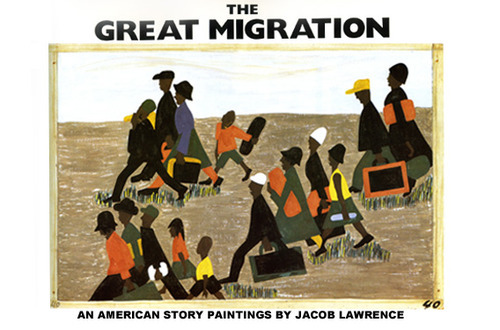

THE PHILLIP’S COLLECTION, one of the greatest yet intimate American art museums, holds some interesting clues about the future for America’s 11 million or so undocumented immigrants. This cozy museum is around the corner from IOM’s DC office and within walking distance of the Capitol steps, where Barack Obama held his public presidential inauguration ceremony on Monday. Few commented on overture in Obama’s speech to a looming battle soon to be joined over America’s immigration laws .
One of my favorite exhibits in the Philips Collection is, as it happens, about migration to Chicago (among other Northern cities), where the young Obama cut his teeth as a community organizer. It’s a set of paintings by Jacob Lawrence known as the Migration series. They tells the story of the exodus of African-Americans who left their homes and farms in the Deep South of the US between 1916 and 1960. They traveled to northern industrial cities, fleeing the racism of Jim Crow laws and seeking economic opportunities for their families.
This is the community which Barack Obama served as a young college graduate, when he turned his back on the high salaries of corporate America and moved to the South Side of Chicago. From June 1985 to May 1988, he worked as a community organizer, helping Chicago residents, churches, and local government improve their atrocious housing conditions, set up job training programs for the unemployed and after-school programs for youth.
It is hardly a surprise that the man, who worked to help the descendants of African-American migrant communities in his youth, has now waded into immigration reform, perhaps the most toxic political battle in America, in his second term as President.
In his inauguration speech he used the most uplifting language to make his pitch: “Our journey is not complete until we find a better way to welcome the striving, hopeful immigrants who still see America as a land of opportunity,” he said.
“Until bright young students and engineers are enlisted in our workforce, rather than expelled from our country.”
Republicans and Democrats now agree on increasing the number of visas for highly-skilled immigrants. Left unspoken is the expectation that President Obama will make increasing visas for skilled workers contingent on wide-ranging changes to immigration laws. Its been widely reported that Administration officials “leaked” the news that absent agreement by Congress on finding a path to citizenship for many of those living clandestine lives in the U.S.. There will be no extra visas for the highly skilled immigrants.
As Business Week tersely points out: “These immigrants aren’t the “bright young” future job-creators Obama lauded in his speech. Most work dirty jobs for low wages, and many lack high-school diplomas. They’re the undocumented workers that Republican governors in Arizona, Georgia, Alabama, and other states have driven away with tough anti-immigration laws.”
But change is on the way and the Administration has already moved to allow families to stay together while spouses and children work to obtain green cards, which typically takes up to a year to complete. Previously they had to return to their home countries and wait up to 10 years before seeking legal entry into the U.S.
Back in the quiet sanctuary of the Phillips Collection, it’s easy to imagine the hardships suffered by African-American’s fleeing in the Deep South. The shameful reality of lynching is not often touched upon in modern American culture, with few exceptions, but suffer they did as they were lured north by newspapers telling of better housing and jobs.
Many of the undocumented immigrants living in the shadows in the US, in fear of family separation and deportation, came for the same sorts of reasons. Whether they will be allowed to stay, is about to be played out in the second term of the one-time community organizer turned President, a man who started his career battling for the underdog.
If you enjoyed this, you may wish to read: The Great Migration: Journey to the North by Greenfield and Gilchrist
Leonard Doyle is the head of Online Communications for IOM